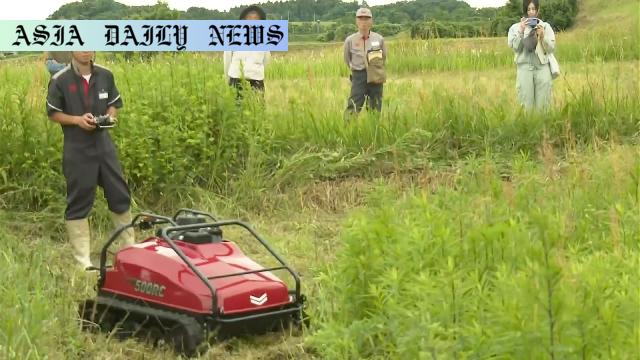Smart Farming: Remote-controlled mowers showcased to assist aging Japanese farmers, tackling labor shortages in terraced fields.

Introduction: Smart Farming to Tackle Aging and Labor Shortages
The agricultural world in Miyagi Prefecture, Japan, witnessed a revolutionary step forward with the introduction of remote-controlled mowers. As aging farmers face dwindling labor resources, smart farming has emerged as a viable solution to reduce the physical strain and enhance operational efficiency. On Monday, a regional agricultural administration office in Kurihara City organized a demonstration of modern mowing machines specifically designed to handle the unique challenges of terraced fields, signaling a shift towards technology-driven agriculture.
The Problem: Aging Farmers and Manual Labor
Terraced rice fields in northeastern Japan are an iconic representation of traditional farming, but they also come with significant challenges. The steep and uneven terrain has traditionally required manual mowing and maintenance, making it an arduous task for farmers—many of whom are aging. Labor shortages in mountainous farming communities have further exacerbated this issue. The physical strain of these tasks has led to growing calls for innovative solutions to preserve the agricultural traditions while reducing individual workloads. The introduction of remote-controlled mowers aims to directly address these challenges.
The Demonstration: A Glimpse of the Future
At the event, around 80 farmers gathered to witness nine mowers developed by five manufacturers in action. Each machine demonstrated unique features tailored to operate efficiently in challenging conditions. One standout model featured a base unit and a mobile component connected by wires. The device showcased its ability to traverse steep slopes with precision, cutting grass steadily while descending and being pulled back uphill efficiently by wires. The demonstration highlighted how these innovations could make maintaining terraced fields a more manageable process for farmers of all ages.
Farmers’ Perspectives on the Technology
The reception among farmers was overwhelmingly positive. For many, the introduction of these machines marks a turning point in how they approach labor-intensive tasks. One farmer in his 50s expressed enthusiasm about the potential relief such technology could bring, as manual mowing has been a long-standing challenge. Others emphasized how this innovation might not just be a convenience but a necessity to ensure the sustainability of farming in aging and labor-deprived communities. The sentiment was clear: embracing smart farming technology is no longer optional but essential for the future of agriculture in these regions.
A Vision for the Future: Smart Farming as a Strategy
The demonstration in Miyagi Prefecture is part of a broader effort to integrate smart technologies into farming practices. As labor shortages and aging populations continue to impact rural areas, advancements such as remote-controlled mowers pave the way for a more efficient and sustainable approach to agriculture. Beyond reducing physical strain, these technologies can encourage younger generations to participate in farming, knowing that modern tools simplify and optimize traditional processes. By investing in smart farming tools, Japan is taking proactive steps towards securing its agricultural legacy while adapting to the realities of modern demographics and market demands.
Commentary
The Significance of Smart Farming in Today’s World
The introduction of remote-controlled mowers in Miyagi Prefecture is an inspiring example of how technology can address deeply entrenched challenges. Farming has always been one of the most labor-intensive professions, and in regions like northeastern Japan, the rugged landscape amplifies manual difficulties. As global populations age and fewer young people seek agricultural careers, innovations like smart farming must take center stage. This event not only provides a glimpse of the future but encourages meaningful discourse on how best to integrate technology to maintain sustainability and tradition simultaneously.
Blending Tradition with Innovation
What’s particularly remarkable about this development is its ability to combine tradition with modernity. Terraced rice fields are a visual and cultural representation of Japan’s farming heritage. Yet, they demand a level of manual labor that is not feasible for aging farmers. The remote-controlled mowers, with their ability to navigate uneven slopes, ensure the preservation of these iconic fields without placing undue strain on farmers. Such technologies represent how innovations can respect and uphold agricultural legacies while meeting contemporary challenges head-on.
Smart Farming for the Future
Looking ahead, the potential of smart farming is immense—not just in Japan but globally. From precision irrigation to autonomous plowing, integrating advanced technologies into agriculture could redefine how food is produced and distributed. The demonstration in Miyagi Prefecture serves as a reminder that technology need not disrupt traditional ways of life but, instead, can complement and strengthen them. By acknowledging the specific needs of farmers and tailoring solutions appropriately, innovations like these remote-controlled mowers offer hope for a sustainable farming future.


